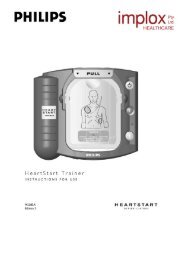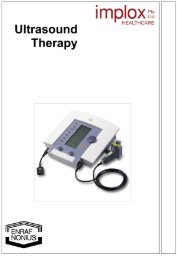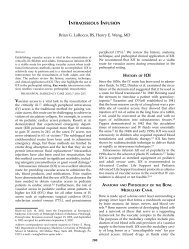Low and medium Frequency Electrotherapy - Implox
Low and medium Frequency Electrotherapy - Implox
Low and medium Frequency Electrotherapy - Implox
You also want an ePaper? Increase the reach of your titles
YUMPU automatically turns print PDFs into web optimized ePapers that Google loves.
1 CONSTANT CURRENT (CC) VERSUS CONSTANT VOLTAGE<br />
(CV)<br />
1.1 Introduction<br />
In physiotherapy, both constant current (CC) <strong>and</strong> constant voltage (CV) electrotherapy equipment is now available.<br />
However, until recently, <strong>and</strong> particularly in Europe, virtually all the electrotherapy equipment in use worked on the CC<br />
principle. Before assessing the value of both characteristics in practice, we shall first consider the underlying<br />
principles.<br />
The term ‘current’ (in the human body’ refers to a flow of ions. Current (I) is expressed in milliampere (mA). The force<br />
required to make the ions flow is the potential (expressed in volt = V). The flow of ions between a pair of applied<br />
electrodes is hindered by the body tissues. The resistance met by the ion flow is expressed in ohm (= Ω).<br />
The current meets the greatest resistance in the skin, the subcutaneous fat tissue <strong>and</strong> bony structures (24.28) . The<br />
resistance of the skin is not always the same. It can be influenced by such factors as the thickness of the epidermis<br />
<strong>and</strong> subcutaneous fat tissue, moistness of the skin (transpiration), blood supply <strong>and</strong> metabolism.<br />
The resistance of the skin can also be reduced artificially by:<br />
• moistening the skin<br />
• increasing the blood supply (in advance)<br />
• allowing current to flow for a length of time.<br />
1.2 Constant Current<br />
There is a fixed relationship between potential (V), current (I) <strong>and</strong> resistance (I).<br />
This is expressed by Ohm´s law: V =I.R.<br />
As the resistance of the skin fluctuates during treatment, Ohm´s law implies that the current can increase (strongly),<br />
resulting in an unpleasant sensation for the patient. With low-frequency direct current types, this undesirable increase<br />
in amplitude could cause damage of the skin.<br />
Constant Current equipment avoids these effects, as the selected current amplitude is maintained at a constant value<br />
(I.R↑ = V↑).<br />
1.3 Constant voltage<br />
The constant Current principle is a good choice for stationary techniques. However, it can lead to problems in<br />
dynamic application techniques, in which the effective area of the electrode is continually changing. The patient will<br />
experience this as an increase in 0amplitude, although, in fact, the amplitude does not increase. The increased<br />
sensation of current is due to an increase in the current density. This is not only unpleasant for the patient, but can<br />
also lead to an incorrect interpretation in electrodiagnostics. There can also be disconnection <strong>and</strong> connection<br />
reactions when the electrode is withdrawn <strong>and</strong> replaced.<br />
These problems do not occur in equipment working on the Constant Voltage principle. In this case, if the effective<br />
electrode area is reduced, which is equivalent to an increase in the resistance, the amplitude will also be reduced<br />
(V : R↑ = I↓), so that the current density remains the same. The patient will experience no change in the sensation of<br />
current, <strong>and</strong> there will also be no disconnection or connection reactions, so that the patient experiences the current<br />
as safe <strong>and</strong> comfortable.<br />
1.4 Constant Current <strong>and</strong> Constant Voltage in practice<br />
The combination of both principles in one electrotherapy unit offers a wealth of possibilities for treatment. If the unit<br />
has two channels, stationary <strong>and</strong> dynamic techniques can be combined in one treatment session. In practice, this<br />
offers benefits in several areas of application:<br />
• (bilateral) stationary treatment techniques;<br />
• diagnosis <strong>and</strong>/or treatment with the same unit;<br />
• combined stationary <strong>and</strong> dynamic treatment techniques (e.g. stationary treatment of a peripheral pain point<br />
combined with dynamic treatment for localizing trigger points at the segmental innervation level);<br />
• the localization of motor trigger points;<br />
• reduction of patients’ fear of electric current.<br />
6















